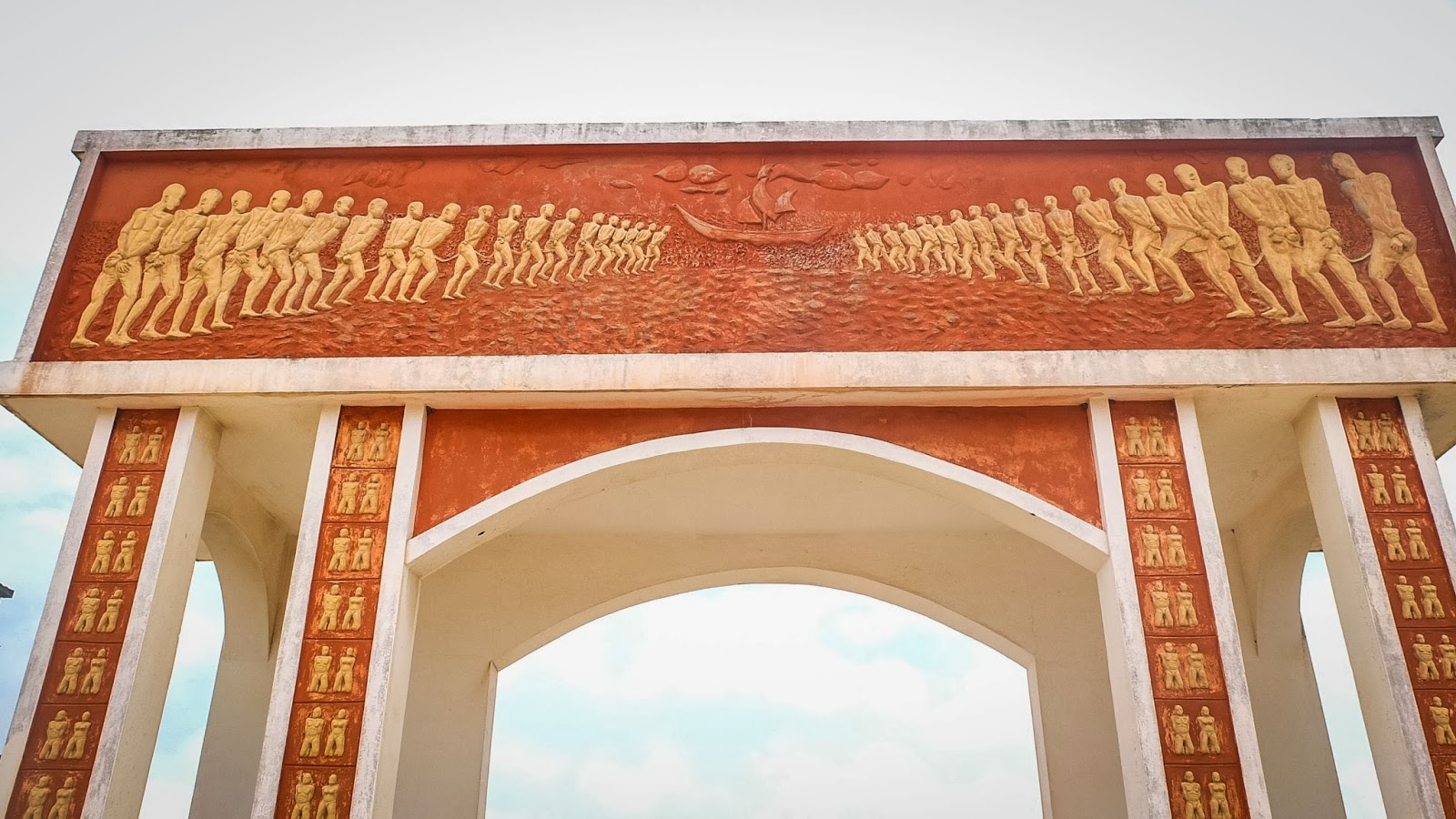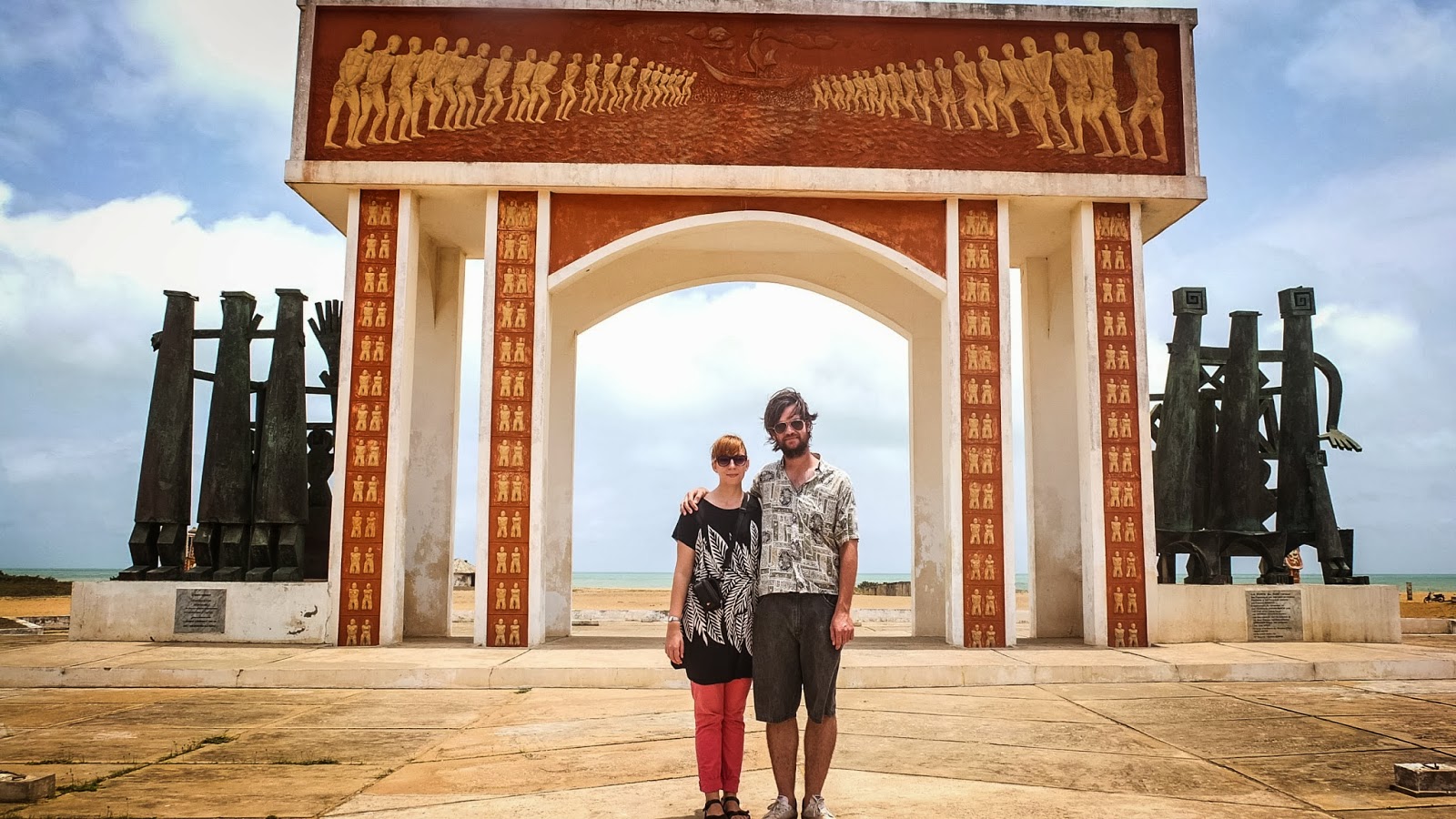Voyages Afrique de l'Ouest: Benin #1 - Voodoo Snake Temples and The Route of the Slaves in Ouidah
1Wednesday, 12 March 2014 by Renee
Our next stop on the road was Ouidah, home to the world's largest annual voodoo conference. An overloaded taxi to the border, an uneventful border crossing, and another taxi and a moto ride and we were in Ouidah, Benin. We found our guesthouse, Le Jardin Secret which would definitely recommend to anyone passing through - basic but comfortable rooms in a gorgeous garden, decorated with artworks you can buy from by local artists (judging by the quality I'd guess real ones and not just stoned rastas painting for tourists!)

After recovering from the journey, we set out in the afternoon in search of the Python Temple. While voodoo and animist beliefs are popular through West Africa and beyond, in many places they are viewed by educated locals as unsophisticated and talked about and practiced in hushed tones. (My hilarious and lovely Gabonese French teacher was somewhat horrified to find our Legba voudoun in our lounge room and suggested we ought to hide it in the bedroom). But in Benin, Voodoo is the official religion, and in Ouidah, the Python is sacred, worthy of its own temple even.
You can go there to pray and talk to the python gods, manifested in a whole room full of pythons. They let them out at night and reportedly travel all through town. It's thought to be really great luck to find one of them in your house, and locals bring them back to the temple the next day. I wasn't thrilled about the idea, but as long as they keep the green mambas away I'm cool with it. (Though, not nearly as cool as Stephen our tour guide, who wears his python friend like a fashion accessory on a runway so cool you've never heard of it...)
After that we wandered around town and found a small chop bar to have dinner and a beer. I'm sorry-o to Ghanaians reading this, but I'd have to say so far the Francophone countries of West Africa were winning my taste buds. (In all fairness, what did the Brits have to offer Ghana in terms of cuisine? Bread?)
The next day we headed off for the Route des Esclaves, (the route of the slaves). Benin was once known as the Kingdom of Dahomey, and it played a huge part in the slave trade - our guide suggested 12 million people were taken from Benin alone. For some perspective, Benin's current population is about 10 million....
The Route of the Slaves markes the last 5km of the treacherous journey slaves were put through after being captured in the north and brought out to sea. Thanks to our bad French, we ended up at the end first and toured the route back to front (how postmodern!) but I'll reverse the order for impact here...
The route starts at the site of the slave market, where the dominant tribes would bring their captives, human beings with thoughts and feelings like you and me, to sell to the various colonial men to take the *cough* "civilised" world.
The Route then travels to monuments marking the dungeons where sold slaves were kept, and often died, while waiting for ships to arrive

I'm also fascinated by how much these figures reminded me of the Australian surf brand Mambo. Does anyone know if there's an actual link? It would certainly not be the first time artistic direction wasstolen appropriated from West Africa (think Picasso and cubism, for starters) but that's whole blog post or PhD thesis of its own...

After recovering from the journey, we set out in the afternoon in search of the Python Temple. While voodoo and animist beliefs are popular through West Africa and beyond, in many places they are viewed by educated locals as unsophisticated and talked about and practiced in hushed tones. (My hilarious and lovely Gabonese French teacher was somewhat horrified to find our Legba voudoun in our lounge room and suggested we ought to hide it in the bedroom). But in Benin, Voodoo is the official religion, and in Ouidah, the Python is sacred, worthy of its own temple even.
You can go there to pray and talk to the python gods, manifested in a whole room full of pythons. They let them out at night and reportedly travel all through town. It's thought to be really great luck to find one of them in your house, and locals bring them back to the temple the next day. I wasn't thrilled about the idea, but as long as they keep the green mambas away I'm cool with it. (Though, not nearly as cool as Stephen our tour guide, who wears his python friend like a fashion accessory on a runway so cool you've never heard of it...)
After that we wandered around town and found a small chop bar to have dinner and a beer. I'm sorry-o to Ghanaians reading this, but I'd have to say so far the Francophone countries of West Africa were winning my taste buds. (In all fairness, what did the Brits have to offer Ghana in terms of cuisine? Bread?)
The next day we headed off for the Route des Esclaves, (the route of the slaves). Benin was once known as the Kingdom of Dahomey, and it played a huge part in the slave trade - our guide suggested 12 million people were taken from Benin alone. For some perspective, Benin's current population is about 10 million....
The Route of the Slaves markes the last 5km of the treacherous journey slaves were put through after being captured in the north and brought out to sea. Thanks to our bad French, we ended up at the end first and toured the route back to front (how postmodern!) but I'll reverse the order for impact here...
The route starts at the site of the slave market, where the dominant tribes would bring their captives, human beings with thoughts and feelings like you and me, to sell to the various colonial men to take the *cough* "civilised" world.
The Route then travels to monuments marking the dungeons where sold slaves were kept, and often died, while waiting for ships to arrive

The last section is marked with monuments to mythological creatures and historical figures such as this amazon warrior, who played a huge and impressive role in the Kingdom of Dahomey.
I'm also fascinated by how much these figures reminded me of the Australian surf brand Mambo. Does anyone know if there's an actual link? It would certainly not be the first time artistic direction was
The end of the route, the "door of no return" is marked with it's own sombre monument to the millions of lives lost to the slave trade, with two voodoo spirits watching to welcome the spirits of those lost back to their homeland so they may be at peace.
Powered by Blogger.
Labels





















Wow, sombre indeed. I'm loving this insight into francophone West Africa. And awesome photos!
ReplyDelete